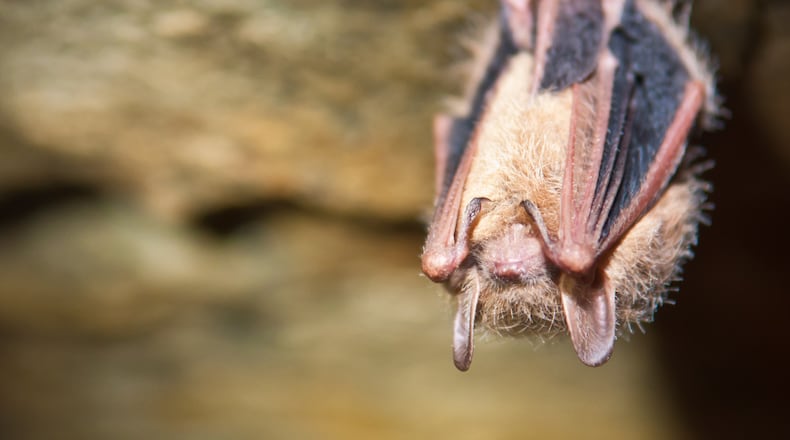In other words, our tendency to support and care more about big, cuddly-looking animals with big eyes and soft fur than other valuable critters. Such as bats.
Ohio is home to at least ten different bat species. They’re not rodents. The’re not related to shrews either. Four of them are currently on an endangered or threatened list of one kind or another. But the real truth is we don’t know a lot about their habits and needs.
We do know that they’re declining in population, some as much as 97% in recent years.
Native species include:
- Big brown bat
- Eastern red bat
- Eastern small-footed bat
- Evening bat
- Hoary bat
- Indiana bat (endangered)
- Little brown bat (endangered)
- Northern long-eared bat (federally threatened)
- Silver-haired bat
- Tri-colored bat (endangered)
Generally speaking, bat species in Ohio have a lot of similarities. All are insectivores and eat insects of one kind or another, often eating while flying. Most are rather small and brown. Weights are measured in ounces and inches.
That makes identifying and separating the actual species of Little Brown Bat from every other little brown bat something of a trick, especially in flight. They mate in the fall and have delayed fertilization that takes place in the spring. Most females have one or two offspring (called pups — there’s your obscure trivia answer) per year. That’s not many by small animal standards and means their numbers can’t bounce back like many tiny creatures when something extraordinary happens.
They often congregate together and sometimes form groups numbering in the hundreds.
Not blind, better
Bats are not blind. In fact, some see a broader light spectrum than humans. Their eyes are adapted to the dark and low-light situations and are sensitive to light. But in addition to that, they can use echolocation.
They emit a high-pitched noise or frequency and then are able to “hear” the returning echo of the sound from various object to locate prey and avoid obstacles in the dark.
Home is the difference
Because they are insectivores, they need to be where the bugs are. Some estimates put their success rate at 1 insect every 7 seconds. That makes them valuable for controlling mosquitoes and other pests. It also means winter in Southwest Ohio would mean slim pickings, and they need a different plan.
Some Ohio bats, including the Hoary, Eastern Red, Evening, and Silver-haired bat, migrate. Through the bug-heavy seasons, they roost in trees. When the bugs disappear in cooler weather, they migrate south, some as far as Central America.
The remaining are cave-dwelling bats and include the northern long-eared, Indiana, Rafineque’s big-eared, eastern small-footed, little brown, big brown, and tri-colored bats. In the summer, they can use a variety of roosts from barns to hollow trees. But as the temperature drops, they seek something with a more consistent thermostat setting. Caves are ideal.
Because they’re not feeding, they hibernate (hibernacula) to conserve energy awakening occasionally throughout the winter. Different species of bats often share the same caves. For that reason, the Cave Protection Act in the Ohio Revised Code 1517 was created to protect cave life and habitat, including hibernating bats.
Non-native threats
Habitat loss is one issue for the bat population decline. They prefer to return to the same sites for summer and winter seasonal cycles. The loss of mature forests and the development of other land add stress to their lifecycle. But beginning around 2010, an even larger threat has emerged on the scene in Ohio.
White Nose Syndrome, caused by an invasive fungus Pseudogymnoascus destructans, has wrecked havoc on populations. Believed to be spread from bat to bat, it’s identified by a white fungus on their nose and wings.
It disrupts hibernation, depletes energy stores, and ultimately results in death. According to a report in the Ohio Bat Conservation Plan, a mine in Preble County saw an average decline across species of 89.5% from 2012 to 2016.
Leave them be
Bats are accurate fliers; they need to be to catch flying bugs, and are unlikely to get caught in anyone’s hair. They do frequently carry rabies but aren’t aggressive. Like all wildlife, if you see one acting strangely, on the ground or out during daylight hours for example, don’t mess with it. Almost all bites occur through humans’ mishandling bats, not the other way around. Leave it alone and call 1-800-WILDLIFE.
In fact, the leave-it-alone guideline should be applied to any bats anywhere they are encountered, including homes. There are two periods which Ohioans are restricted from removing bats as directed by the Ohio Department of Natural Resources (ODNR).
Those periods are:
- May 16 through July 31, when five or more bats are present
- Oct. 15 through March 31, if any bats are present
Call 1-800-WILDLIFE or email wildlife.batexclusion@dnr.ohio.gov for additional information on bat exclusion authorization.
Aside from that, just hang tight and enjoy the herky-jerky movements of a flying mammal as they track down mosquitoes across the evening sky. Know that’s one mosquito that won’t bite you. Then another. And another…
Devin Meister is a local outdoors and wildlife enthusiast and has a blog called “Average Guy Outdoors.” He is an Ohio University graduate. Reach him at meister.devin@gmail.com.
Resources
Learn More
Amazing Bats - National Trails Parks and Recreation Administration Building
Ages 6 & Older, Friday, July 11, 8 – 9:30 p.m.
Learn why bats are important and which ones live in Ohio during this fun program with Marne Titchenell from Ohio State University Extension. Learn how bats find their way in the dark, and then we’ll head outside to look for bats in the wild! Kids must come with a grown-up.
https://ntprd.org/amazing-bats/
The Mysteries & Science of Bats - Five Rivers Metro Parks
Ages 10-17, Saturday, July 26, 7:30 - 9:30 p.m., $3.00 | Financial Assistance
Discover the unique behaviors, diverse species, and ecological roles of these incredible nocturnal mammals. Learn about bat echolocation, their diets, habitats, and the important ways they support ecosystems. Weather Dependent.
https://www.metroparks.org/programs-events-finder/?program_number=T134&api=programs&type=program
Bat Roost Monitoring - Five Rivers Metro Parks
Ages 3-13, Saturday, Aug. 29, 8 - 9:30 p.m.
https://www.metroparks.org/programs-events-finder/?program_number=T159&api=programs&type=program
Take part in an Ohio Division of Wildlife study to assess bat populations, and learn how you can help bats. Weather Dependent.
Build a Bat Box
Create a summer daytime roosting area for bats
About Bats ODNR
https://ohiodnr.gov/search/?search_query=bats
Bats in Homes
https://ohiodnr.gov/discover-and-learn/land-water/issues-for-landowners/nuisance-bats
Bat Conservation
Public Land - A Quick Note
While the proposed legislation that would have sold millions of acres of our public land is dormant for now, our land and habitat always need our attention. Our uplands and prairies are disappearing at rates that would cause global uproars if they had the broad visual appeal of forested mountains or the romance of the rain forest. Less than 4% of an original 170 million acres remain. The truth is, prairies are better at turning CO2 into oxygen and at sequestering carbon than rainforests. They just don’t have the “charisma mega environ” of these other landscapes. Unless you’re interested in pollinators and upland birds
Pheasants Forever/Quail Forever (PF/QF) is one of the most dedicated organizations to restoring those habitats and lands wherever they are found. Thursday, July 10th, the Greater Dayton chapter is hosting a pint night, with a percentage of sales benefiting the chapter.
Greater Dayton PF/QF Eudora Pint Night
Thursday, July 10 at 5 p.m.
Eudora Brewing Company - 3022 Wilmington Pike, Kettering, 45429
About the Author


